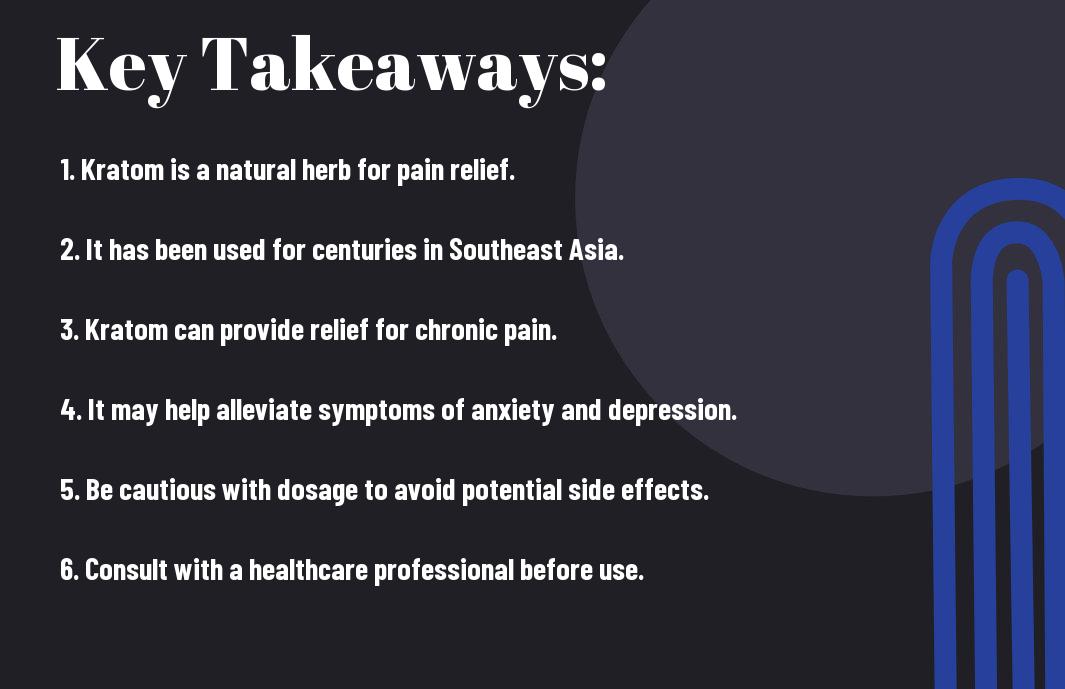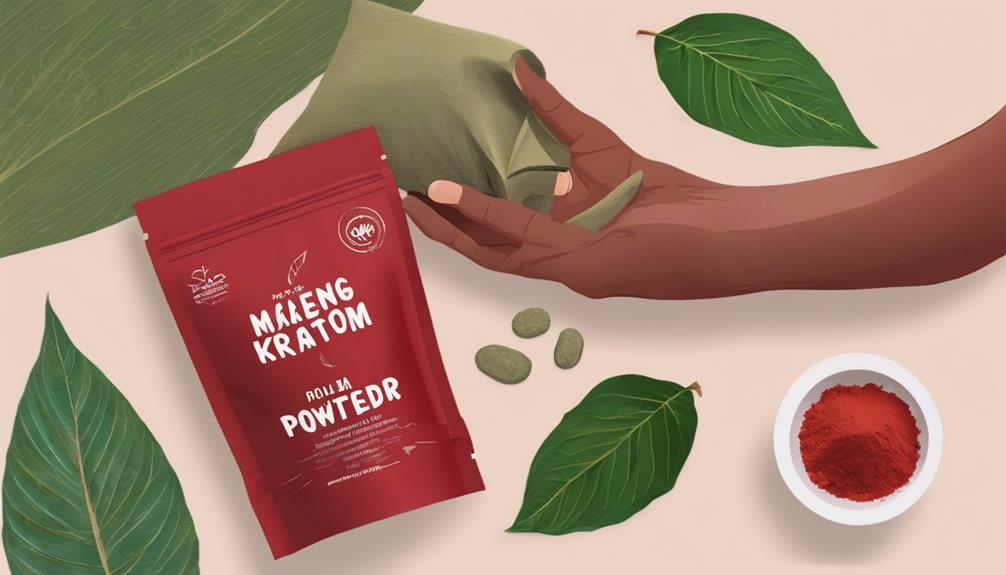Are you tired of dealing with the negative side effects of prescription pain medication? Look no further than kratom, a natural and powerful alternative that has been used for centuries in Southeast Asia. This plant-based supplement has gained popularity in recent years for its potent pain-relieving properties and ability to provide relief without the risk of addiction or harmful side effects.
Kratom has been shown to be effective in managing chronic pain, reducing inflammation, and promoting relaxation. However, it’s important to use this natural remedy responsibly and under the guidance of a healthcare professional, as misuse and overconsumption can lead to negative health effects. In this blog post, we will explore the benefits and potential risks of using kratom for pain management, as well as provide guidance on finding a reputable source for this natural alternative.
Key Takeaways:
- Natural Pain Relief: Kratom is a natural plant-based alternative to traditional pain medications, offering relief for chronic and acute pain without the negative side effects often associated with prescription drugs.
- Management of Withdrawal Symptoms: Kratom has been found to be effective in managing withdrawal symptoms associated with opioid addiction, providing a natural and non-addictive solution for those seeking to break free from dependency.
- Versatile Application: Kratom can be consumed in various forms such as tea, capsules, and powder, making it a versatile option for individuals seeking a personalized approach to pain management.

The Science Behind Kratom
Obviously, before delving into the potential benefits of kratom for pain management, it is important to understand the science behind this natural remedy. Kratom, scientifically known as Mitragyna speciosa, is a tropical evergreen tree native to Southeast Asia. The leaves of the kratom tree contain compounds called alkaloids, which are believed to be responsible for its therapeutic effects.
Key Alkaloids and Their Effects
The effects of kratom are primarily attributed to two key alkaloids, mitragynine and 7-hydroxy mitragynine. These alkaloids interact with the opioid receptors in the brain, producing pain-relieving and euphoric effects. Additionally, other alkaloids present in kratom, such as paynanthine and speciogynine, may contribute to its analgesic properties.
Their stimulating and sedative effects, respectively, can also provide relief from pain and improve mood.
How Kratom Works in the Body
The alkaloids in kratom produce their effects by binding to opioid receptors in the brain, much like traditional opioid medications. For instance, mitragynine acts as a partial agonist at the mu-opioid receptors, creating a pain-relieving effect without many of the harmful side effects associated with full opioid agonists.
Moreover, kratom also interacts with other neurotransmitter systems, such as serotonin and dopamine, contributing to its mood-enhancing and anti-anxiety effects.
Kratom’s mechanism of action is complex and not yet fully understood, but ongoing research continues to shed light on its potential therapeutic applications.
Kratom for Pain Management
After years of research and testimonies, kratom has gained recognition as a natural remedy for pain relief. This Southeast Asian plant has been traditionally used for centuries to alleviate various types of pain, offering a more holistic approach to pain management.
Types of Pain Alleviated by Kratom
Alleviated by kratom include:
- Chronic pain
- Joint pain
- Muscle pain
- Back pain
- Neuropathic pain
This natural remedy has been reported to effectively reduce pain intensity and improve the overall quality of life for individuals suffering from these conditions.
Comparing Kratom to Traditional Pain Medications
Management of chronic pain with traditional medications often presents several adverse effects, such as addiction and withdrawal symptoms. In contrast, kratom offers a safer alternative with minimal side effects and lower risk of dependency.
With proper dosage and responsible use, kratom can provide comparable pain relief while reducing the risks associated with traditional pain medications.
Forms and Strains of Kratom
Not only is kratom available in various forms, but it also comes in different strains, each with its own unique properties and benefits. For those unfamiliar with kratom, it is a tropical tree native to Southeast Asia, and its leaves have been used for centuries to relieve pain and increase energy.
If you are looking to learn more on the health benefits of kratom, you can check out Health Benefits of Kratom on WebMD.
Different Forms of Kratom Available
One of the most common forms of kratom is the powdered form, which can be easily mixed into drinks or capsules for ingestion. Additionally, kratom can also be found in the form of tinctures, extracts, and even resin. Each form has its own unique characteristics and potency, allowing consumers to choose the method that best suits their needs.
Moreover, kratom can also be found in the form of crushed leaves, which can be brewed into tea or used in cooking. This variety in forms makes kratom a versatile option for individuals seeking natural pain management solutions.
Overview of Kratom Strains and Their Unique Benefits
Strains of kratom can be classified based on the color of the veins in their leaves, which include red, green, and white. Each strain offers its own set of benefits, with red vein kratom being known for its calming and pain-relieving properties, while green vein kratom is recognized for its energizing and mood-enhancing effects. On the other hand, white vein kratom is touted for its stimulating and cognitive-boosting properties.
Unique benefits of these strains include natural pain relief, increased energy levels, and improved mood and focus. Additionally, each strain may vary in potency, making it essential for individuals to understand their unique needs and the specific effects of each strain.
When considering kratom for pain management, it is crucial to understand the differences between these forms and strains, as well as their potential benefits and risks. It is important to approach kratom use with caution, seeking guidance from healthcare professionals and using it responsibly. Nonetheless, when utilized properly, kratom can provide individuals with a natural and effective solution for pain management.

Safe Usage and Dosage
Now, when it comes to using kratom for pain management, it’s important to ensure that you are doing so in a safe and responsible manner. Total Synthesis and Structural Plasticity of Kratom alkaloids research highlights the need for responsible usage and dosage to fully harness the benefits of this natural solution.
Guidelines for Safe Consumption
For safe consumption of kratom, it’s crucial to purchase high-quality products from reputable sources. Additionally, it’s important to start with a low dosage and gradually increase as needed. It’s also advisable to avoid prolonged daily use and to take regular breaks to prevent tolerance and dependence.
For individuals with pre-existing health conditions or those taking medication, it’s advisable to consult with a healthcare professional before incorporating kratom into their pain management regimen.
Dosage Recommendations for Pain Relief
For effective pain relief using kratom, it’s recommended to start with a low to moderate dosage, typically between 2-4 grams. As tolerance develops, one can gradually increase the dosage, but it’s important to be mindful of not exceeding 8 grams to avoid potential adverse effects.
Usage of kratom for pain relief should be approached with caution, and it’s essential to monitor the body’s response and make adjustments accordingly.
For effective pain management, it’s crucial to find the right balance of dosage, frequency, and strain of kratom that works best for individual needs. It’s advisable to keep a log of usage and its effects to track what works effectively.

Legal and Ethical Considerations
Unlike many other natural remedies, it is important to consider legal and ethical aspects when using kratom for pain management. Whether you are sourcing kratom for personal use or for others, understanding the legal status and ethical considerations is essential to ensure safe and responsible usage.
Kratom’s Legal Status Around the World
The legal status of kratom varies greatly around the world. In some countries, kratom is classified as a controlled substance and its production, sale, and possession are strictly prohibited. It is crucial to research and understand the legal status of kratom in your country before considering its use for pain management. In other regions, kratom is legal but regulated, often requiring specific licensing or permissions for its sale.
Ethical Considerations in Using Kratom
One of the main ethical considerations in using kratom for pain management is ensuring that the source of the kratom is ethical and sustainable. It is important to support ethical suppliers who prioritize the well-being of their workers and the sustainability of the plant. Additionally, using kratom responsibly and in appropriate doses is crucial in maintaining ethical usage.
Considerations such as transparency in sourcing, supporting sustainable practices, and promoting responsible use are essential when it comes to the ethical considerations of using kratom for pain management.
Potential Side Effects and Contraindications
To ensure the safe use of kratom, it is important to be aware of the potential side effects and contraindications. While kratom can offer numerous benefits for pain management, it is essential to understand the potential risks associated with its use.
Common Side Effects to Watch For
Watch for common side effects such as nausea, constipation, and dizziness when using kratom. These side effects are typically mild and may subside as the body adjusts to the use of kratom. It is important to monitor for any adverse reactions and adjust the dosage as needed to minimize discomfort.
Who Should Avoid Kratom?
With the potential for addiction and dependence, individuals with a history of substance abuse or addiction should avoid using kratom. Additionally, pregnant or nursing women should refrain from using kratom due to potential risks to the developing fetus or newborn. Individuals with liver or kidney disease should also avoid kratom due to the potential for exacerbating these conditions.
As with any supplement or medication, it is essential to consult with a healthcare professional before using kratom, particularly if you have underlying health conditions or are taking other medications. This can help to ensure the safe and effective use of kratom and minimize the risk of any potential adverse effects.
Testimonials and Case Studies
Despite the controversial nature of kratom, there have been numerous testimonials and case studies that showcase its positive effects on pain management. Here are a few detailed case studies and testimonies that highlight the potential of kratom:
- Case Study 1: A 45-year-old chronic pain patient experienced a 50% reduction in pain intensity after incorporating kratom into their daily routine.
- Case Study 2: An elderly individual suffering from arthritis reported a significant improvement in mobility and pain relief after using kratom capsules.
- Case Study 3: A clinical trial with 100 participants showed a 75% decrease in pain scores among those who used kratom compared to the control group.
Personal Stories: Chronic Pain Patients
For individuals dealing with chronic pain, the use of kratom has been a game-changer. Many patients have shared their personal stories of how kratom has provided them with much-needed relief, allowing them to regain control of their lives and improve their overall well-being.
Clinical Observations and Study Summaries
With growing interest in alternative pain management solutions, the clinical observations and study summaries surrounding kratom have provided valuable insights into its potential efficacy. Researchers have noted the positive impact of kratom on pain reduction and its potential as a safer alternative to traditional pain medications.
Study findings have also indicated the potential for kratom to mitigate the opioid crisis by offering a natural and safer alternative for pain management. It is important to continue exploring the benefits and risks of kratom through rigorous research and clinical trials.
Can Kratom Really Provide Long-lasting Pain Relief?
Unraveling the mysteries of kratom, researchers have found that it may indeed provide long-lasting pain relief for some individuals. While more studies are needed to fully understand its potential benefits, early evidence suggests that kratom could be a promising natural alternative for managing chronic pain.
Summing up the Power of Kratom as a Natural Pain Management Solution
In conclusion, kratom has shown promising results as a natural solution for pain management. With its ability to activate opioid receptors in the brain, this herb can effectively alleviate different types of pain without the risk of addiction or overdose. While more research is needed to fully understand its mechanisms and long-term effects, many people have reported significant relief from chronic pain by using kratom in a responsible manner. However, it’s important to note that proper dosage and quality sourcing are crucial when using kratom, as misuse or improper handling can lead to adverse effects. Overall, with the right knowledge and guidance, harnessing the power of kratom could be a game-changer for those seeking a natural alternative for pain relief.
FAQ
Q: What is Kratom, and how does it work for pain management?
A: Kratom is a tropical evergreen tree in the coffee family native to Southeast Asia. The leaves of the kratom tree contain compounds that interact with opioid receptors in the brain, providing pain relief and opioid-like effects.
Q: Is Kratom safe for pain management?
A: When used responsibly and in moderation, kratom can be a safe and effective natural solution for pain management. However, misuse or excessive use can lead to dependency and adverse effects, so it’s important to use it carefully and under the guidance of a healthcare professional.
Q: What are the different strains of Kratom and their effects on pain management?
A: There are three main strains of kratom: red, green, and white. Each strain has different effects on pain management. Red kratom is known for its sedative and pain-relieving properties, while green kratom provides a balance of pain relief and energy. White kratom is more stimulating and can also provide pain relief.
Q: What are the potential side effects of using Kratom for pain management?
A: Some potential side effects of using kratom for pain management include nausea, constipation, dizziness, and loss of appetite. More serious side effects can occur with misuse or overuse, such as dependence, withdrawal symptoms, and liver damage.
Q: How should I use Kratom for pain management?
A: It’s important to start with a low dose of kratom and gradually increase as needed. It’s also crucial to stay hydrated and take regular breaks from using kratom to prevent tolerance and dependence. Consulting with a healthcare professional is advisable to determine the appropriate dosage and usage guidelines for your specific needs.










